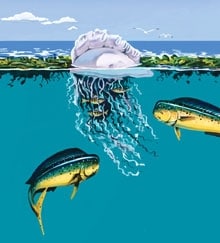
Dolphin are widely known as one of the premier eating machines in the ocean. Much of the time, anglers can make quick work of them by casting lures, trolling dead baits, jigging and live-baiting. But there are times when dolphin-especially oversize fish-become fickle. When that occurs, the following tactics may turn the dolphin-catching tide decidedly in your favor.
Throw Them a Curve
Sometimes you just need to go for it.
|| |—| || |WAR ZONE: Seemingly safe amid jellyfish tentacles, baitfish can’t escape prowling dolphin. Illustration: Steve Sanford| “Thinking outside the box when choosing bait for dolphin makes sense,” says veteran Key Largo, Florida, charter Captain George Mitchell. “I’ve learned that the best baits are ones found right where dolphin are living. If you find a floating tree offshore, for example, and there are baby mackerel or rainbow runners swimming around it, with some big dolphin nearby, using mini mackerel or runners for bait is likely the best thing you can do. I catch those fish with light spinning tackle and shrimp or jigs, so I can use them as bait. Don’t be surprised if you hook a big dolphin that hits a bait before you can get it back to the boat for proper rigging.”
At times, however, bizarre baits go from the sublime to the ridiculous. Mitchell recalls trolling a weedline that had an abundance of Portuguese man-o-war jellyfish mixed in with it. He used ballyhoo rather unsuccessfully for dolphin along the weeds, even though he could see dolphin from the tower of his boat. Finally, a large sea turtle rose up to the surface and ate some of these jellyfish.
“Instantly several dolphin went into a frenzy and started striking around the turtle where it had just eaten the man-o-war,” Mitchell says. “I ran my boat over and looked at some of the jellyfish in the weeds and noticed their tentacles hanging down into the water were full of small, striped, jack-like baitfish that must be impervious to stings of man-o-war. When the turtle ate the jellyfish, the baitfish had nowhere to hide. The dolphin picked off the striped fish like they were sitting ducks.
“We quickly, and carefully so as not to get stung, used a dip net to catch some jellyfish with their tentacle-hiding baitfish,” he says. “Then we rigged the baits alive, pitching them to the weedline with spinning rods, and immediately started catching dolphin-big ones, too.
“Most fishermen think that’s an oddball bait for dolphin. But dolphin are used to feeding on that sort of stuff,” Mitchell continues. “It’s what they’ve got to do to make a living in the open ocean, and they do a pretty good job of it. And that’s often what an angler has got to figure out if he’s got any chance of catching heavyweight bull dolphin with consistency.”
Chumeroni
Pasta makes the perfect dolphin draw.
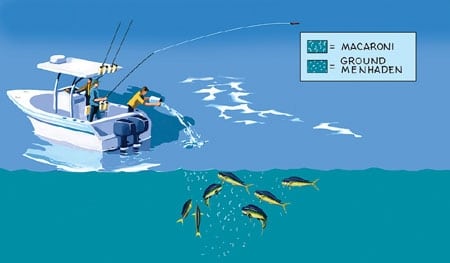
DOLPHIN AL DENTE: Mixed with ground menhaden, cooked macaroni makes great chum.
Illustration: Steve Sanford
Chumming works well for just about any fish that eats, including dolphin. But there is some specialized fine-tuning that dupes dolphin consistently for veteran Cocodrie, Louisiana, captains Tommy Pellegrin and his son Eric.
“If school-size dolphin weighing two to five pounds get finicky, I mix macaroni noodles with menhaden oil or ground menhaden we make from castnetted bait,” Pellegrin says. “Macaroni noodles absorb menhaden oil, and you get twice as much chum volume with the noodles. Eric and I use small, white plastic grubtail jigs for lures on schoolie dolphin, and we soak the grubs in chum before fishing. The grubs then smell like menhaden, and the little white lure tails also look like macaroni pieces in the chum, which dolphin eat like crazy. It works really well on fish that weigh less than ten pounds.”
Chug The Chum
Big bulls can’t resist the plop of plugs.
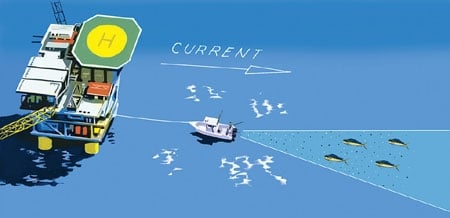
CHUGGER PLUGGING: Drawn in with chum, big dolphin are pushovers for big plugs.
Illustration: Steve Sanford
For bigger dolphin weighing 20, 30, 40 pounds and more, Captain Eric Pellegrin uses a different sort of chumming tactic.
“We tie off to floating, deep-water oil rigs and chum with one-inch square chunks of sardines,” Eric says. “It’s important to set up a chum line drift just right so the chum and your lures are moving away from a rig, or you’ll get cut off.
“When dolphin start working chum, we cast big surface-chugger plugs to them using heavy spinning tackle, with 80-pound-test Power Pro braided line and 80-pound fluorocarbon leaders.”
Eric’s favorite chugger for big, chummed-up dolphin is a six-inch-long Angry Popper, made by Louisiana-based Frenzy Tackle (www.frenzytackle.com).
“It’s a big-fish lure that’s extremely well made and usable right out of the box,” Eric says. “It’s a good imitation of a flying fish. Blue marlin have been caught on them, and we regularly catch 100-pound yellowfin tuna on them as well. So they can handle the biggest dolphin.”
Glow, chrome and blue are good colors. The lure sinks slowly, which Eric says is good, because it forces an angler to fish the lure fast to keep it on the surface, where its chugging, popping and churning turns on giant dolphin like few other lures.
“I got a school of 40 or 50 big dolphin chummed up one day, and we really knocked them dead with Angry Poppers,” he says. “We boated 15 fish, and each weighed between 15 and 45 pounds.”
Oh Buoy
Tie one on for nonstop action.
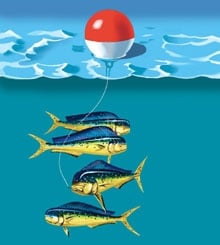
| |SCHOOL’S IN: Keep schoolie fish near your boat by rigging a caught fish to a boat bumper or mooring buoy. Illustration: Steve Sanford| Charter Captain Don Dingman, of Orange Park, Florida, is a widely traveled angler with plenty of dolphin-catching experience. He says most anglers know the old trick of keeping a hooked dolphin in the water to hold the rest of the school within casting range. But an advanced twist to this tactic is to take a hooked dolphin and tie it off with fishing line to a floating boat buoy. Then allow the buoy and dolphin to drift away from your fishing boat.
“It’s easy to do, and it helps prevent schoolie dolphin from spooking once you start catching them,” says Dingman. “You can use a small-boat bumper or even a large floating ball you’d use to moor a boat-whatever is onboard that floats. I rig a ball or buoy with some type of snap clip to attach easily to my fishing line. If I’m trolling and catch a dolphin, I’ll just unclip the trolling leader holding the fish, and snap it to the ball. It’s easy and fast and gets a hooked fish away from the boat so a dolphin school stays with that first fish.”
Once Dingman has a buoy-rigged dolphin set up, he’ll motor well away from it and cast big chugger plugs and jigs to the buoy to collect more dolphin.
“You can work on a school a longer time from long range than you can if you keep a hooked fish near the boat,” he says. “One time fishing in Costa Rica with Captain Jeff Dry out of Los Sue-os, we caught 34 fish from a single school, all on chugger plugs and spinning tackle. They weighed anywhere from 15 to 39 pounds.”
Weed Whacking
Speed troll a weedline for hookups galore.
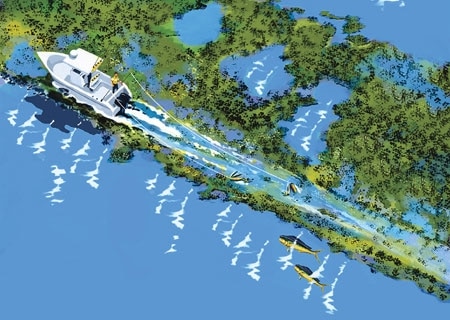
SPEED TRAP: When trolled quickly, cedar plugs will shed weeds and catch dolphin.
Illustration: Steve Sanford
North Carolina angler and Red Drum Tackle Shop (www.reddrumtackle.com) owner Bob Eakes trolls fast for dolphin because it helps eliminate weed tangles when working sargassum.
“I drag a pair of six-inch-long cedar plugs at about 12 or 13 knots because at that speed, most weeds simply blow off the hooks of the lures and it sure helps you locate dolphin faster,” Eakes says.
“Not many guys use cedar plugs, but they look a lot like flying fish when they’re swimming, and I think that’s why dolphin hit them so well. Plus cedar plugs are so simple to use.”
Eakes prefers to troll six-inch-long Mold Craft plastic squid lures rigged with single 7/0, long-shank Mustad 34007 hooks at high speeds. He crimps a big split shot to the hook shank, which acts like a keel. While fast-trolling, a shot-rigged hook rides up in a squid, rarely fouling in weeds.
“When I find a dolphin school, I shut down the engines after the first small fish comes to the boat. I immediately unhook it, bridle the fish at the nose, fasten it to an 80-pound outfit and pitch it back overboard,” says Eakes. “This does two things: It keeps a schoolie alive in the water so we can catch more dolphin from the school as they hang around the boat, and should a marlin suddenly show up excited by the dolphin frenzy, I have a rigged outfit ready for that billfish challenge. Once or twice each year I’ll hook a blue marlin doing this with dolphin.”
Eakes also makes certain to keep another heavy spinning outfit with a ballyhoo rigged on a large hook, 20-pound-test line and a 50-pound leader. “Often when we’re fishing small schoolie dolphin weighing less than ten pounds, a bigger fish weighing 30 or 40 pounds or more shows up,” he says. “When a big bull appears, I want to have a heavy outfit ready to roll.”
Depth Chargers
Learn the keys to catching dolphin down deep.
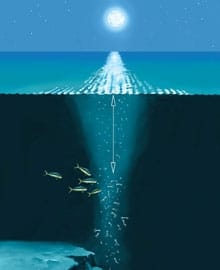
| |DEEP THOUGHTS: Fishing with downriggers may be the answer for taking deep-dwelling dolphin. Illustration: Steve Sanford| South Carolina fisheries biologist Don Hammond knows as much about dolphin as anyone on the planet, since he’s been largely involved with scientific studies concerning the fish for many years. Thanks to his use of electronic tags, Hammond recently learned that dolphin frequent deeper water than previously imagined.
“We tagged a 25-pound bull off South Carolina and in ten days of tracking that fish, it spent a surprisingly large amount of time in deep water-sometimes more than 240 feet down,” Hammond says. “Yet some days that fish spent much of its time at the surface, in fact once it hovered there for 15 straight hours. But frequently it spent a lot of time 100 to 160 feet down.
“At night that dolphin definitely was deeper than during daylight periods. The nighttime average was about 70 feet down, which might indicate that dolphin feed on deep-water creatures that rise up when the sun sets. Dolphin spend more time at the surface during the day when food is more available there.”
Satellite information collected from tagged dolphin indicate that the fish averaged 25 daily trips to the surface from the depths, presumably to feed. Each surface visit averaged 22 minutes. Deep dives were of short duration, Hammond believes, because water temperature at great depths even in June off South Carolina were below 70 degrees.
“That dolphin spent the great majority of its time in water temperatures between 74 and 77 degrees, but ventured into waters reaching temperatures from 67 to 85 degrees,” says Hammond. “This data may help anglers get a better handle on dolphin and provide answers to catching them.”
Fishing lures deeper, perhaps with downriggers, may be an overlooked tactic. And it is also wise to seek their preferred water temperature of 74 to 77 degrees.









